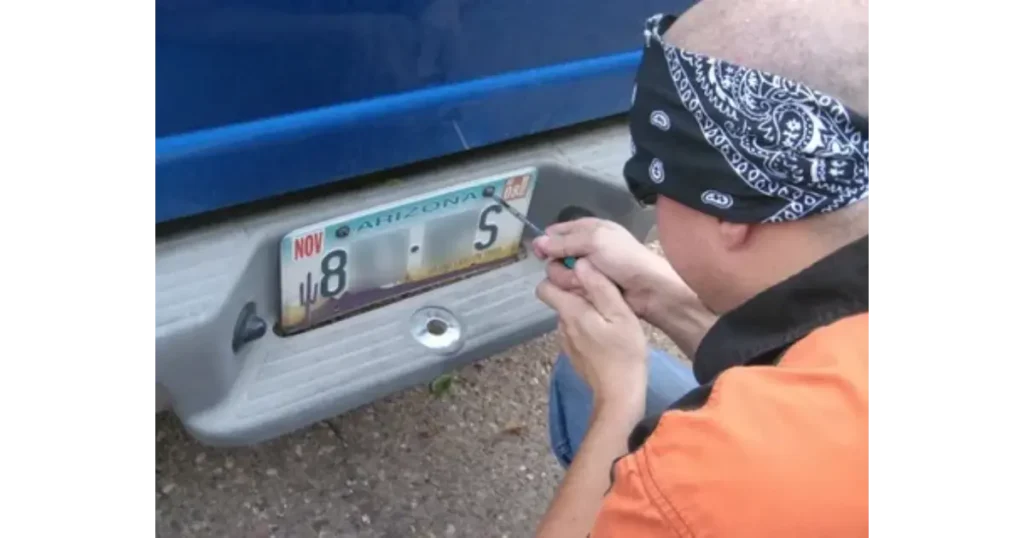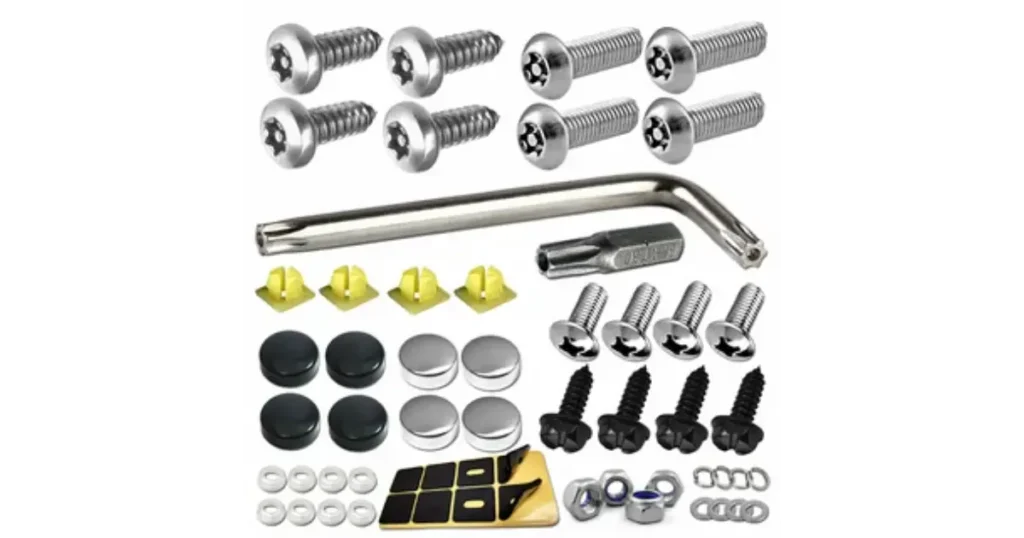Removing rusted license plate screws can be a bit tricky, but it’s manageable with the right tools and techniques. Here are some steps you can follow:
Penetrating Oil: Apply a penetrating oil like WD-40 or PB Blaster to the rusted screws. Let it soak in for several minutes (or even hours if the rust is severe). This helps to break down the rust and lubricate the screw, making it easier to remove.
Use the Right Screwdriver: Use the correct size and type. A screwdriver that fits snugly will reduce the risk of stripping the screw head.
Tap the Screwdriver: Gently tap the end of the screwdriver with a hammer while it’s inserted in the screw’s head. This can help to break up the rust.
Apply Heat: If the screw doesn’t budge, carefully apply heat using a heat gun or a hairdryer set to the highest setting. The expansion and contraction of the metal caused by the heat can help to loosen the screw.
Manual Impact Driver: If the screw is still stuck, a manual impact driver can be very effective. This tool turns the screw as it is struck with a hammer, applying both rotational force and downward pressure.
Vice-Grips or Pliers: If the screw head is stripped, you might need to use vice-grips or pliers to grip the head of the screw and turn it.
Drilling Out the Screw: As a last resort, you can drill out the screw. Start with a tiny drill bit and gradually increase the size until you can remove the screw. Be careful not to damage the surrounding area.
Prevent Future Rust: Once you’ve removed the screws, consider replacing them with stainless steel or coated screws to prevent future rusting.
Navigating the Challenge of Rusted License Plate Screws

Removing rusted license plate screws can often seem like a daunting task for many vehicle owners. The process, albeit seemingly straightforward, involves careful manoeuvring to avoid damage to the vehicle. Rusted screws are a common issue, especially in areas with high moisture or salt exposure.
Dealing with them requires specific techniques and tools. This blog post aims to guide you through the efficient removal of rusted license plate screws, ensuring the integrity of your vehicle is maintained while achieving a successful outcome.
The challenge with rusted screws is not just their stubborn refusal to budge but also the potential harm aggressive removal methods can pose to the surrounding areas of the vehicle.
We will focus on practical and gentle methods for your car’s exterior. We will explore tools and products that can assist in this process, from penetrating oils to manual impact drivers, and discuss when and how to use them effectively.
Read Also : Why Do People Cover Their License Plates?
What are Rusted License Plate Screws?
In the world of vehicle maintenance, the term “rusted license plate screws refers to a common problem faced by many car owners. To fully grasp the implications and challenges of this issue, it’s essential to understand both components of the term: the nature of rust and the function of license plate screws.
| Column 1: Aspect | Column 2: Description | Column 3: Importance |
| Nature of Rust | Rust is the result of iron oxidation due to exposure to moisture, oxygen, and corrosive elements. | Understanding rust formation helps in preventive measures. |
| Challenges Faced | Rusted license plate screws are challenging to remove, and forceful methods can cause damage to the vehicle. | Identifying the challenges helps in safe removal. |
| Preventive Measures | Using corrosion-resistant screws, applying rust inhibitors, and regular maintenance can prevent rust formation. | Taking preventive steps extends the life of license plate screws and maintains vehicle aesthetics. |
Rust Formation: The Science Behind the Scourge
Rust is the result of a chemical reaction called oxidation, where iron (in the screws) reacts with oxygen and moisture. This reaction forms iron oxide, commonly known as rust, characterized by its reddish-brown colour.
The process is accelerated in environments with higher humidity, saltwater exposure, or corrosive chemicals. Rust not only affects the aesthetic appeal of the vehicle but also weakens the metal, making the screws brittle and difficult to remove.
License Plate Screws: Their Role and Vulnerabilities

License plate screws are used to attach the license plate to the vehicle securely. These screws are typically made of metal, making them prone to rusting, especially if they are not stainless steel or treated to resist corrosion. The location of these screws, often exposed to the elements, further increases their susceptibility to rust.
The Implications of Rusted Screws
Rusted license plate screws pose several challenges:
- Difficulty in Removal: The primary issue is the difficulty in removing them without damaging the screw head, the license plate, or the car itself.
- Potential Damage: Forceful removal methods can strip the screw head or harm the vehicle’s exterior.
- Safety and Compliance: In some cases, it can become a legal concern if the license plate falls off due to failed screws.
Read More : What Is The Size Of License Plate Screws?
Comprehensive Guide: Effective Removal of Rusted License Plate Screws
Dealing with rusted license plate screws can be a frustrating experience, but with the right approach, it’s a challenge that can be overcome. This comprehensive guide will walk you through the process step by step, ensuring a safe and effective removal.
Step 1: Preliminary Assessment
Before diving into the removal process, assess the extent of rust and the condition of the screws. This will help you determine the most suitable method and tools for the job.
Step 2: Application of Penetrating Oil
The first line of action is the application of a penetrating oil like WD-40 or a similar product. Spray it generously over and around the screws and allow it to soak for at least 15-30 minutes. This helps in loosening the rust bond and lubricating the screw, making it easier to turn.
Step 3: Using the Right Tools
Select a screwdriver that fits the screw head perfectly. A poor fit increases the risk of stripping the screw head. If the screw is already partially stripped, consider using a screw extractor.
Step 4: Applying Controlled Force
Gently tap the handle of the screwdriver with a hammer while it’s engaged with the screw head. This action can help break the rust seal. Then, apply steady pressure as you turn the screwdriver. Avoid excessive force to prevent stripping the head.
Step 5: Heat Application
If the screw remains stuck, apply heat around the screw area using a heat gun or a hair dryer. The expansion and contraction of the metal can aid in loosening the screw.
Step 6: Alternative Techniques
If traditional tools fail, leverage a pair of vice grips or pliers to grip the head of the screw and turn it. For screws that are severely rusted or stripped, drilling them out might be the last resort.
Step 7: Clean Up and Prevention
Once removed, clean the area and consider applying a rust inhibitor or anti-seize compound before inserting new screws. Opting for stainless steel or coated screws can prevent future rusting.
Step 8: Regular Maintenance
Regularly inspect and maintain the screws to prevent rust formation. Simple steps like cleaning and occasional lubrication can extend the life of license plate screws.
- Corrosion Prevention: Techniques and products to prevent rust and corrosion on metal parts of a vehicle.
- Screw Extraction Methods: Various methods and tools are used for extracting screws that are damaged, stripped, or stuck.
- Vehicle Maintenance Tips: General advice on maintaining different vehicle parts, including rust-prone areas.
- DIY Auto Repairs: Vehicle owners can perform simple repair tasks at home, including tools and safety tips.
- Rust Treatment Solutions: Products and homemade remedies for treating and removing rust from metal surfaces.
- License Plate Maintenance: Care and maintenance tips for license plates and their attachments.
- Automotive Tools and Equipment: Tools and helpful equipment for various automotive repairs, including screw removal.
- Protective Coatings for Metals: Information about coatings and finishes that protect metal parts of a vehicle from rusting.
- Environmental Factors and Vehicle Care: How ecological factors like humidity and salt exposure affect vehicles and how to mitigate these effects.
- Safety in Vehicle Repairs: Best practices for ensuring safety while performing various vehicle repairs.
Summary and Key Takeaways
Our comprehensive guide on “How To Remove Rusted License Plate Screws” provided an in-depth look at effectively tackling this common automotive issue. Key takeaways include the importance of penetrating oil, the right tools for the job, and applying controlled force.
And alternative methods such as heat application or screw extraction. We emphasized the significance of preventive measures like using corrosion-resistant screws and regular maintenance to avoid future rusting.
Frequently Asked Questions
Can I prevent my license plate screws from rusting?
Yes, applying a rust inhibitor or anti-seize compound and using stainless steel or coated screws can significantly reduce the risk of rusting.
What should I do if I strip the screw head?
If the screw head is stripped, use a screw extractor or grip the head with vice grips or pliers to remove it.
Is it safe to use heat to remove a rusted screw?
Yes, applying heat can be safe if done cautiously. Avoid excessive heat and focus on the area around the screw.
Can rusted license plate screws damage my vehicle?
Rusted screws themselves don’t damage the vehicle, but forceful removal without the proper technique can cause harm.
Should I seek professional help for removing rusted screws?
If you’re uncomfortable with the process or if the screw is severely rusted, it’s advisable to seek professional assistance.
Conclusion
The process of removing rusted license plate screws may seem daunting, but armed with the proper knowledge and techniques, it becomes a manageable task. This comprehensive guide has shed light on the challenges posed by rusted screws, the science behind rust formation, and a step-by-step method for their safe and effective removal.
Remember, preventive measures such as using corrosion-resistant screws and regular maintenance play a crucial role in keeping rust at bay. By following the advice provided here, you can ensure that your vehicle remains free from the grip of rusted license plate screws, preserving its appearance and integrity for years to come.
